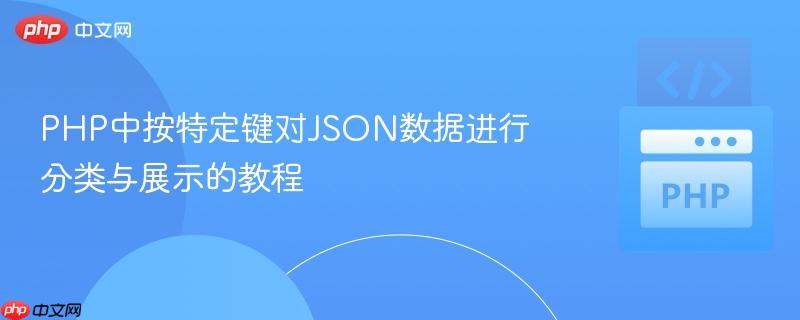
本教程详细介绍了如何在PHP中高效处理JSON数据,特别是如何根据JSON对象中的特定键(如’category’)对其进行分类和分组。我们将通过实际代码示例,演示如何将扁平化的JSON数组转换为按类别组织的结构化数据,并最终以清晰、可读的方式在网页上进行展示,提升数据处理的灵活性和用户体验。
1. 引言:理解JSON数据分类的需求
在web开发中,我们经常需要处理来自api或文件的json数据。这些数据通常以扁平的数组形式呈现,每个元素包含多个键值对。然而,在某些场景下,我们需要根据json数据中的某个特定键(例如“category”)对数据进行分组和归类,以便于展示或进一步处理。例如,将一系列文章链接按照其所属的类别进行分组显示,可以极大地提升用户体验和数据可读性。
假设我们有如下结构的JSON数据,其中包含文章链接(article)及其所属的类别(category):
[ { "article": "https://example.com/article1", "category": "Cat2" }, { "article": "https://example.com/article2", "category": "Cat1" }, { "article": "https://example.com/article3", "category": "Cat1" }, { "article": "https://example.com/article4", "category": "Cat2" }, { "article": "https://example.com/article5", "category": "Cat1" } ]
我们的目标是将其转换为按类别分组的结构,并最终以类似以下格式输出:
Cat 1 -- --- https://example.com/article2 --- https://example.com/article3 --- https://example.com/article5 Cat 2 -- --- https://example.com/article1 --- https://example.com/article4
2. 核心实现:JSON数据的分类与重构
要在PHP中实现这种分类,我们需要首先解码JSON字符串,然后遍历解码后的数组,根据category键的值来构建一个新的、按类别分组的关联数组。
2.1 JSON解码
首先,我们需要将JSON字符串解码为PHP数组。如果JSON数据存储在文件中,可以使用file_get_contents()读取文件内容,然后通过json_decode()进行解码。
立即学习“PHP免费学习笔记(深入)”;
<?php // 模拟从文件读取或直接定义的JSON字符串 $jsonString = '[{ "article": "https://example.com/article1", "category": "Cat2" }, { "article": "https://example.com/article2", "category": "Cat1" }, { "article": "https://example.com/article3", "category": "Cat1" }, { "article": "https://example.com/article4", "category": "Cat2" }, { "article": "https://example.com/article5", "category": "Cat1" }]'; // 解码JSON字符串为PHP关联数组 // 第二个参数为 true 表示解码为关联数组,而不是对象 $data = json_decode($jsonString, true); // 检查JSON解码是否成功 if (json_last_error() !== JSON_ERROR_NONE) { die("JSON解码失败: " . json_last_error_msg()); } ?>
2.2 构建分类数组
接下来,我们将遍历 $data 数组,并创建一个新的 $categorizedData 数组。这个新数组的键将是类别名称,值将是包含该类别所有文章链接的数组。
<?php $categorizedData = []; foreach ($data as $entry) { $category = $entry['category']; // 获取当前条目的类别 $article = $entry['article']; // 获取当前条目的文章链接 // 如果该类别尚未在 $categorizedData 中作为键存在,则初始化一个空数组 if (!array_key_exists($category, $categorizedData)) { $categorizedData[$category] = []; } // 将当前文章链接添加到对应类别的数组中 $categorizedData[$category][] = $article; } ?>
经过上述处理后,$categorizedData 数组的结构将变为:
<?php /* array(2) { ["Cat2"]=> array(2) { [0]=> string(28) "https://example.com/article1" [1]=> string(28) "https://example.com/article4" } ["Cat1"]=> array(3) { [0]=> string(28) "https://example.com/article2" [1]=> string(28) "https://example.com/article3" [2]=> string(28) "https://example.com/article5" } } */ ?>
可以看到,数据已经成功地按照“Cat1”和“Cat2”进行了分组。
3. 分类数据的展示:模板化输出
一旦数据被重构为按类别分组的形式,我们就可以使用PHP的循环结构将其以美观、可读的方式输出到HTML页面。这通常涉及到嵌套的 foreach 循环。
<!DOCTYPE html> <html lang="zh-CN"> <head> <meta charset="UTF-8"> <meta name="viewport" content="width=device-width, initial-scale=1.0"> <title>分类文章列表</title> <style> body { font-family: Arial, sans-serif; margin: 20px; } h1 { color: #333; border-bottom: 2px solid #eee; padding-bottom: 5px; margin-top: 30px; } ul { list-style: none; padding-left: 20px; } li { margin-bottom: 5px; } a { color: #007bff; text-decoration: none; } a:hover { text-decoration: underline; } </style> </head> <body> <h1>文章分类列表</h1> <?php if (empty($categorizedData)): ?> <p>暂无文章数据。</p> <?php else: ?> <?php foreach ($categorizedData as $category => $articles): ?> <h2><?= htmlspecialchars($category); ?></h2> <ul> <?php foreach ($articles as $articleLink): ?> <li><a href="<?= htmlspecialchars($articleLink); ?>" target="_blank"><?= htmlspecialchars($articleLink); ?></a></li> <?php endforeach; ?> </ul> <?php endforeach; ?> <?php endif; ?> </body> </html>
这段代码将生成如下的HTML输出(略去 zuojiankuohaophpcnhead> 和 <body> 标签):
<h1>文章分类列表</h1> <h2>Cat2</h2> <ul> <li><a href="https://example.com/article1" target="_blank">https://example.com/article1</a></li> <li><a href="https://example.com/article4" target="_blank">https://example.com/article4</a></li> </ul> <h2>Cat1</h2> <ul> <li><a href="https://example.com/article2" target="_blank">https://example.com/article2</a></li> <li><a href="https://example.com/article3" target="_blank">https://example.com/article3</a></li> <li><a href="https://example.com/article5" target="_blank">https://example.com/article5</a></li> </ul>
4. 注意事项与最佳实践
- array_column的局限性: 尽管array_column函数在提取单一列数据时非常有用,但它不能直接用于按某个键进行分组。对于此类分组需求,手动遍历是更直接和高效的方法。
- 错误处理: 在实际应用中,务必对json_decode()的返回值进行检查,并使用json_last_error()和json_last_error_msg()来处理潜在的JSON解析错误。
- 数据量: 对于中小型JSON数据,上述的foreach循环方法效率很高。对于极大规模的JSON文件(GB级别),可能需要考虑流式解析或其他更高级的数据处理策略,但这超出了本教程的范围。
- 安全性: 在将数据输出到HTML时,始终使用htmlspecialchars()来转义用户生成或外部来源的数据,以防止跨站脚本(XSS)攻击。
- 代码分离: 理想情况下,数据处理逻辑(PHP部分)应该与视图展示逻辑(HTML/PHP模板部分)保持分离,以提高代码的可维护性和可读性。
5. 总结
本教程演示了如何在PHP中有效地将扁平化的JSON数据根据特定键进行分类和重构。通过一个简单的foreach循环,我们可以将原始数据转换为更具组织性和可读性的结构,从而便于在网页上进行展示。掌握这种数据处理技巧对于开发动态Web应用和提升用户体验至关重要。
以上就是PHP中按特定键对JSON数据进行分类与展示的教程的详细内容,更多请关注php html js json go 键值对 json数组 lsp php json html xss 关联数组 foreach 字符串 循环 对象 重构


